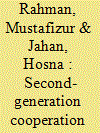| Srl | Item |
| 1 |
ID:
099310


|
|
|
|
|
| Publication |
2010.
|
| Summary/Abstract |
The purpose of this paper is to analyze the economic and environmental implications of Turkey's possible accession to the European Union (EU). The paper focuses on the impacts of three main components of Turkey's possible EU membership: (i) the free movement of labor between the EU and Turkey, (ii) the free movement of capital, and (iii) the burden-sharing of Turkey in terms of the EU's environmental objectives in the horizon of 2020, that is, the reduction of carbon emissions. Among these, a particular focus is placed on the influence of the CO2 emission reduction targets in both regions and their consequences on the carbon price in 2020. We estimate the resource allocation effects of EU climate change policies on both regions by taking into account the likely labor movement from Turkey to the EU and capital movement in the reverse direction. The results show that different emission targets for the two regions bring about a change in comparative advantages and thus a change in interregional competitiveness.
|
|
|
|
|
|
|
|
|
|
|
|
|
|
|
|
| 2 |
ID:
139479


|
|
|
|
|
| Summary/Abstract |
South Asia remains one of the least integrated regions in the world, which is manifested in its lack of connectivity, low levels of intra-regional trade and weak investment flows. On the other hand, there is an apprehension that Southeast and East Asia could fall into a ‘middle income trap’, if they are not able to raise competitive strength and productivity further. In view of this, it is argued that there is a need for a framework of second-generation cooperation and integration embracing these three subregions in Southern Asia. This calls for concerted efforts to leverage existing institutional arrangements and put in place new avenues of subregional and inter-regional cooperation. Expansion of production networks, developments of value chains and greater integration of markets will allow these subregions to translate their respective comparative advantages into competitive advantages. Through harnessing opportunities of technology transfer, connectivity and greater factor mobility, and by taking advantage of cross-regional division of labour, these subregions could promote new patterns of inter-regional trade structure and specialization, which could benefit all the countries of Southern Asia.
|
|
|
|
|
|
|
|
|
|
|
|
|
|
|
|